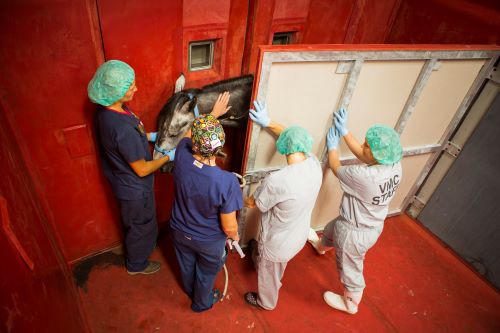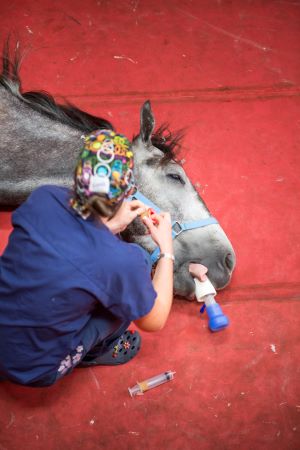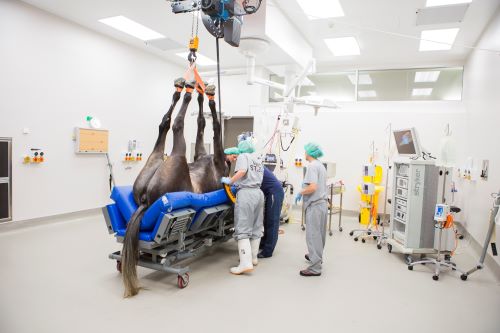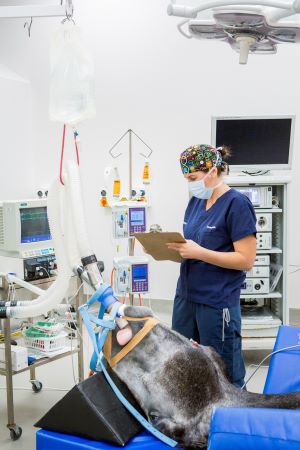Understanding equine anaesthesia
Your horse may require anaesthesia for a variety of health problems, medical procedures or for advanced diagnostic imaging.
Anaesthesia is commonly used for elective procedures such as a castration, to treat a horse that has sustained a wound, or for emergency surgery to treat colic.
Advanced diagnostic imaging techniques such as comupted tomography (CT) scans also require your horse to be anaesthetised so it's immobile and we can take high-quality images.
(This information was adapted from an article by UQ lecturer and Equine veterinary specialist Dr. Allison.J.Stewart BVSc(hons), MS, DACVIM, DACVECC, and Dr. Jo Rainger PhD, BVSc, BVSc(Vet), FANZCVA, Dip Clin Stud(Veterinary Anaesthesia) for Hoofbeats magazine. Read the article)
What is anaesthesia?
Anaesthesia is the temporary loss of sensation and awareness, induced by the controlled (and reversible) suppression of nervous function with drugs.
- It may be regional (when a particular area of the body is numbed like a nerve block in a lame leg) or general (when the whole body is affected).
- When your horse is under general anaesthesia, they are unconscious and don't feel pain. It is useful in situations where it is critical that your horse doesn't move during an operation.
- Horse anaesthesia is associated with some risk so understanding the process can alleviate the anxiety some owners may experience.
- Your veterinarian takes numerous precautions and 99% of the time the anaesthetic is uneventful and the surgery or imaging procedure is successfully performed.
What are the complications for horses?
The complications associated with anaesthesia are:
- muscle damage
- nerve damage resulting in paralysis
- pneumonia
- cardiac arrest
- leg fracture
- suffocation
- trauma during recovery
- eye ulcers.
Owners may be worried about the safety of their horse and anxious about what to expect both before and after. This is especially true when we don’t understand what happens during the procedure, or what can be done beforehand to make sure it all goes as smoothly as possible.
- Take the time to discuss with your vet all aspects of your horse’s health, so they have the full picture, and don’t be afraid to ask questions.
- The more information you have at your fingertips, the more rational you will be about what anaesthesia means for your horse.
How and where is my horse anaesthetised?
How a horse is anaesthetised depends on where it is and the procedure it needs to undergo.
Field anaesthesia
- Is used for veterinary procedures that require anaesthesia and are carried out in a paddock or sand arena.
- It involves injecting anaesthetic drugs intravenously directly into the bloodstream (e.g. ketamine).
- It is normally used for shorter elective or emergency procedures, the most common being colt castration.
Emergencies that may require field anaesthesia are:
- wounds that cannot be safely repaired standing
- mares that are having difficulty foaling.
General (or inhalant) anaesthesia
Is used when horses are anaesthetised in a hospital setting where they are placed on a machine that uses gas anaesthetics and supplemental oxygen to maintain anaesthesia.
How does a vet prepare my horse for anaesthesia?
Your horse is assessed by a veterinarian for both field or hospital anaesthesia.
Before your horse is anaesthetised, the first thing a veterinarian will do is to take a thorough medical history.
- It is important that you alert the veterinarian to any abnormalities in your horse's behaviour or health.
- The veterinarian will then examine your horse, which usually involves:
- taking its temperature
- listening to its heart and lungs
- inspecting the mucous membranes of your horse's gums
- examining the specific parts of anatomy associated with your horse’s injury or illness.
- Most veterinarians will then place an intravenous catheter into your horse's jugular vein to make it easier to safely administer injectable anaesthetic drugs.
- Your horse may be sedated before the catheter is placed if it is uncooperative which they may tend to be when injured, ill or stressed by receiving injections.
How does my horse 'go under' when it is anaesthetised?
Your horse is always sedated before anaesthesia is admistered. The technical term for your horse 'going under' anaesthesia is called 'induction.'
- Once the horse is deeply sedated, anaesthesia can be induced.
- Since most of the drugs used to do this act quickly and leave the body rapidly, they need to be given throughout the surgery/ procedure.
- If your horse undergoes a short procedure, your horse may be ‘topped up’ with smaller doses of injectable anaesthetics
- If your horse undergoes a long procedure, your horse may given 'constant rate infusion.' This is when drugs are given continuously (rather than injected intermittently) to make sure that the body receives the ideal concentration of drugs throughout, and so the anaesthesia level (unconsciousness and loss of sensation) is kept more constant.
- The duration your horse is unconscious is important because the longer they are lying down (recumbent) the greater the incidence of muscle and nerve damage due to pressure and poor blood flow.
- This is more likely if the horse is anaesthetised on the ground rather than on a padded surgical table.
What is the process if my horse is anaesthetised in hospital?
Your horse may be anaesthetised in hospital if a sterile operating room or operating room (OR) is available for the procedure, or if the procedure is going to take a prolonged period of time. For example, if your horse is having colic surgery, throat surgery, arthroscopy, or surgical repair of wounds or fractures.
We may collect blood samples from your horse
We use blood samples to check for infection indicators or liver and kidney disease which could be further worsened by anaesthetic drugs.
For very sick horses preparing for emergency surgery (such as colic surgery), the blood work can help vets decide how best to rehydrate the horse and balance its electrolyte levels using intravenous fluids.
Sometimes, plasma (the liquid portion of the blood containing proteins and nutrients) or blood transfusions may even be required before or during anaesthesia.
Your horse will go into a drop down stall

In hospital, your horse is sedated and undergoes induction in a special padded room called a 'drop down stall' or 'induction/recovery box' with a door which restrains the horse or up against a table that tilts.
It is vital that staff are well trained in horse anaesthesia to avoid injury to personnel and the horse because when your horse becomes unconscious they may lose the ability to coordinate their body movements and can stagger and/or fall.

An endotracheal tube is inserted.
We'll insert an endotracheal tube
Once your horse is unconscious a flexible, plastic tube (endotracheal tube) is placed though the mouth into the trachea or ‘wind pipe’.
This allows your horse to be attached to a machine which administers oxygen and the gas that maintains anaesthesia and allows them to pass freely to and from the lungs.
It can also allow the anaesthetist to ‘breathe’ for your horse if needed, using manual or mechanical ventilation.
Once the tube is inserted, ready for it to be hooked up to the anaesthetic machine, your horse is moved from the drop-down stall into the OR.

We'll move your unconscious horse by hoist
We'll place hobbles below the fetlocks and hoist your horse in an upside down position using a mechanical hoist.
This allows your horse to be positioned correctly and easily for its upcoming procedure.
We'll place your horse on the operating table

Once in the operating room, we'll lower your horse onto a padded, hydrolic surgery table.
The padding is very important to prevent muscle and nerve damage.
Your horse is attached to the anaesthetic machine, intravenous fluids and monitoring equipment so the anaesthetist can monitor your horse's breathing, heart rate and blood pressure.
We'll collect blood samples from your horse's artery to check their lungs and heart are working properly. This can be very important in severely ill horses such as colics.
The anaesthetist monitors your horse’s vital signs so they're kept close to normal values.
- If your horse's blood pressure drops, intravenous fluids and drugs that specifically increase blood pressure can be used to return the blood pressure to normal.
- This is critical for preventing muscle and nerve damage.
Your horse is returned to the drop-down stall after their procedure
Once the procedure is completed, your horse is returned to the padded, drop-down stall where it is closely observed by the anaesthetist until it is standing.
It's vital to carefully monitor your horse during this stage so it doesn't obstruct it's windpipe and suffocate due to reduced control of their airway.
Your horse can also be at risk of stress, and falls/stumbling due to incoordination, during recovery from anaesthesia.
Why is horse anaesthesia associated with risk?
Horses have an increased risk of injury, and occasionally even death, associated with anaesthesia, mainly due to their large body size when compared to other pets such as cats and dogs.
- When lying down, your horse's body weight compresses the muscles and nerves on their underside.
- If your horse is anaesthetised for long periods, muscle and nerve damage can result and may lead to the horse experiencing pain, limb incoordination and an uncontrolled recovery, with potential further injury.
- Breathing is also compromised when your horse is positioned on its side or on its back.
- As horses are flight animals, if your horse isn't sufficiently sedated they can panic during the induction and recovery from anaesthesia which can lead to injury and occasionally catastrophic limb fractures.
- Sedatives and pain relief may be given to your horse to help them stand after coming round from anaesthesia and to allow a smoother recovery.
How can I lessen the risk of anaesthesia to my horse?
One of the main ways to decrease the risk associated with your horse being anaesthetised is through prevention.
Preventing colic surgery
- The anaesthetic and recovery risks for colic surgery are much higher than those of horses having elective hospital procedures such as arthroscopy.
- Preventative health care such as worming and dental care will decrease the likelihood of colic and the need for a horse to undergo this treatment.
- If your horse does develop colic, call your veterinarian promptly.
- The longer your horse suffers from colic, the more likely it is to develop dehydration and shock. The sicker the horse, the higher the risk associated with anaesthesia. Every hour can make a difference.
Preventing emergency surgery
- Property maintenance reduces the likelihood of injuries, the need for wound repairs, and the potential for emergency anaesthesia.
- Well-handled, calm horses sedate more deeply on lower doses of drugs and have smoother inductions and recoveries, which lessens the likelihood of injury from anaesthesia.
Handle young horses early and frequently
- Early and frequent handling of young horses is vital to improving their chances of successful anaesthesia and also decreases the risk for the people involved.
- Anaesthetising unhandled horses is a recipe for disaster, but is a risk vets have to take when a horse is in urgent need of this procedure.
Carefully plan the timing and area for elective field anaesthesia
- When scheduling elective field anaesthesia, you can decrease the chance of complications through careful timing.
- It is best not to schedule these towards the end of the day so your horse can be easily monitored during daylight hours.
- The drugs used to anaesthetise your horse often disrupt their ability to regulate their temperature, so schedule for early morning during summer and during the middle of the day in winter.
- Ensure your horse is caught and calm prior to arrival of the veterinarian since excited horses, or those that have been running around immediately prior, often sedate poorly and need higher doses of anaesthetic drugs - which can lead to more complications.
- Excited horses also often have less smooth inductions and recoveries.
- Choosing the area in which to anaesthetise a horse in the field is also very important.
- The area should have no objects that could injure it during this time (and during recovery).
- If possible, your horse should be on a soft surface such as a grassy paddock or sand arena. This will lessen the likelihood of muscle and nerve damage especially if the procedure is lengthy.
Prepare padding and protective equipment for elective field anaesthesia
- Your horse can be placed on mattresses and padding once they are induced.
- It is also important to pad the underside of the lower elbow and support your horse's upper legs.
- Buckle halters should not be left on during anaesthesia with your horse on its side as the buckle can press on the facial nerve and result in a dropped upper lip following the operation (flat rope halters are often the safest to use on anaesthetised horses).
- Your horse's eyes should be protected from the ground and the sun to prevent eye ulcers and retinal damage.
What is a specialist veterinary anaesthetist?
A specialist anaesthetist is a veterinarian that has undergone a 3-to-5 year supervised training program specifically in anaesthesia.
- During this time, the veterinarian works under the tutelage of one or more specialist anaesthetists, and training programs are closely monitored by a governing body.
- Once the training program is complete, in Australasia, the veterinarian has to pass an extensive examination process set by the Australian and New Zealand College of Veterinary Specialists to become a Fellow and be awarded the initials FANZCVA.
- Only then can they be registered as a specialist, or even use the term ‘specialist’.
- Can your horse hear you?
- Equine metabolic syndrome (EMS) and laminitis
- Identifying and reducing the risk of cellulitis in horses
- Prepare and monitor your expectant mare
- Standing MRI for horses
- UQ case study for treating forelimb lameness
- Understanding equine anaesthesia
- What causes laminitis in horses and how is it treated?
- What is Pituitary pars intermedia dysfunction (PPID)?
- What to do if your horse has a sore eye
